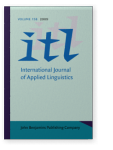Vol. 158 (2009) ► pp.77–96
The Efficacy of Context and Cognitive Expert Patterns in Academic Vocabulary Learning
This research intends to detect which instruction is most advisable for unknown English academic terms in first course students of English Philology. Fot this purpose it evaluates whether or not the context, with a small number of encounters (6) is superior to the visual help (expert cognitive pattern), obtained with the Pathfinder procedure (Schvaneveldt, Durso and Dearholt, 1989; Schvaneveldt, 1990; Thompson, Gomez and Schvaneveldt, 2000), when learning a complex vocabulary set; in this case, academic vocabulary (Coxhead, 1998). Results confirm that both types of instruction are useful when teaching this vocabulary however, context seems to be superior in spite of the small number of encounters used in the instruction. Bearing in mind the ease of getting appropriate contexts of use, this is the type of instruction that our research points to as the most recommendable.
